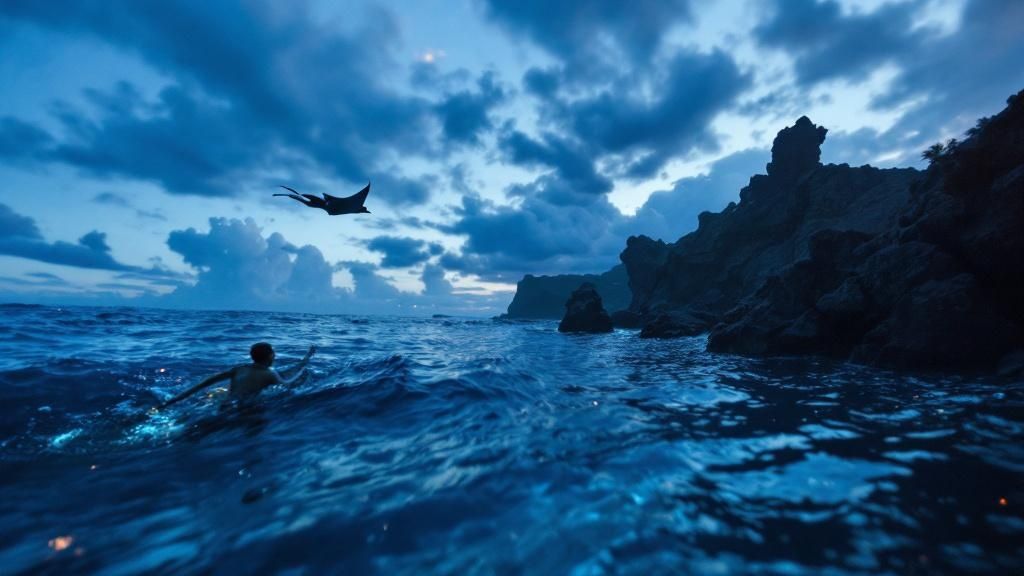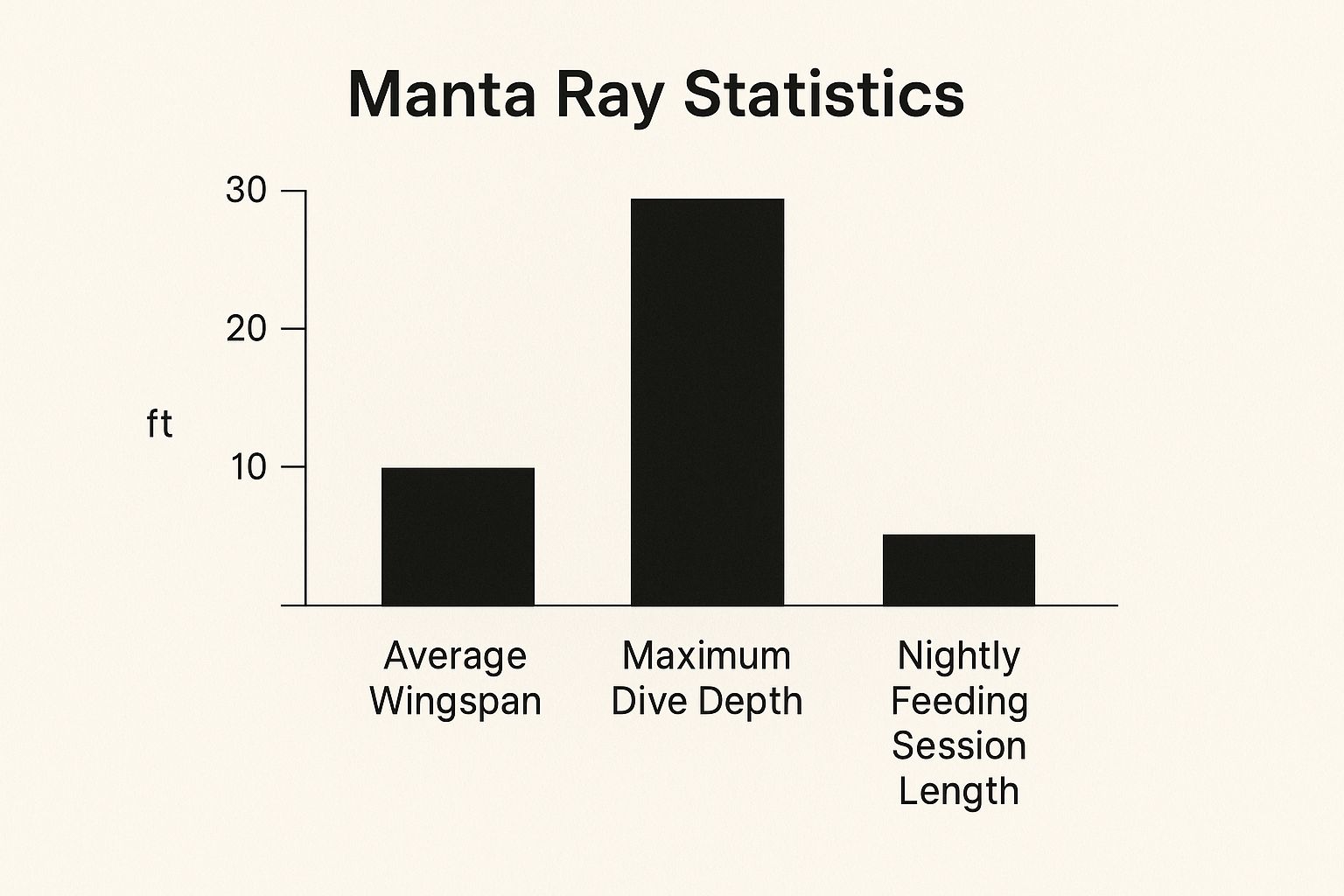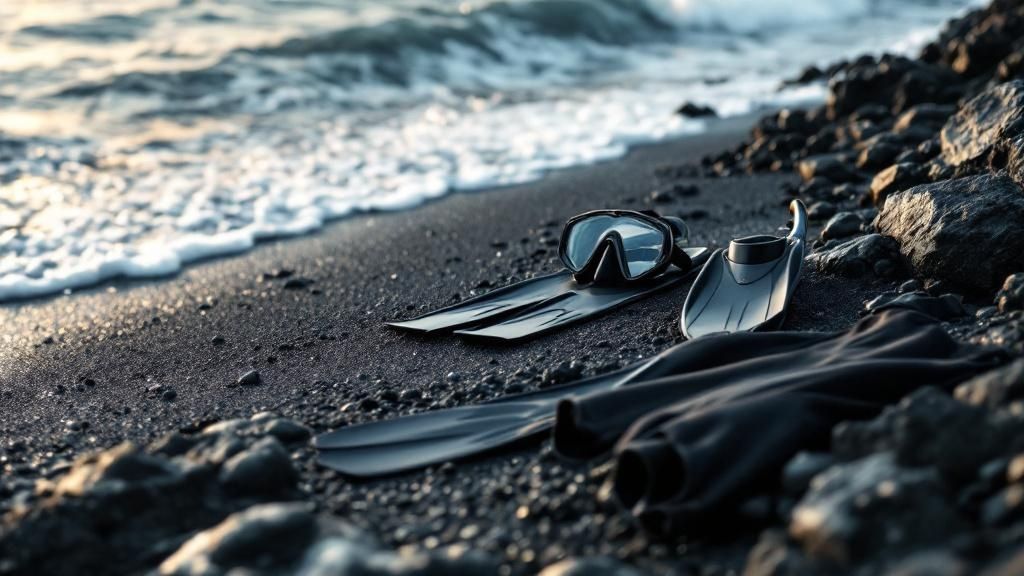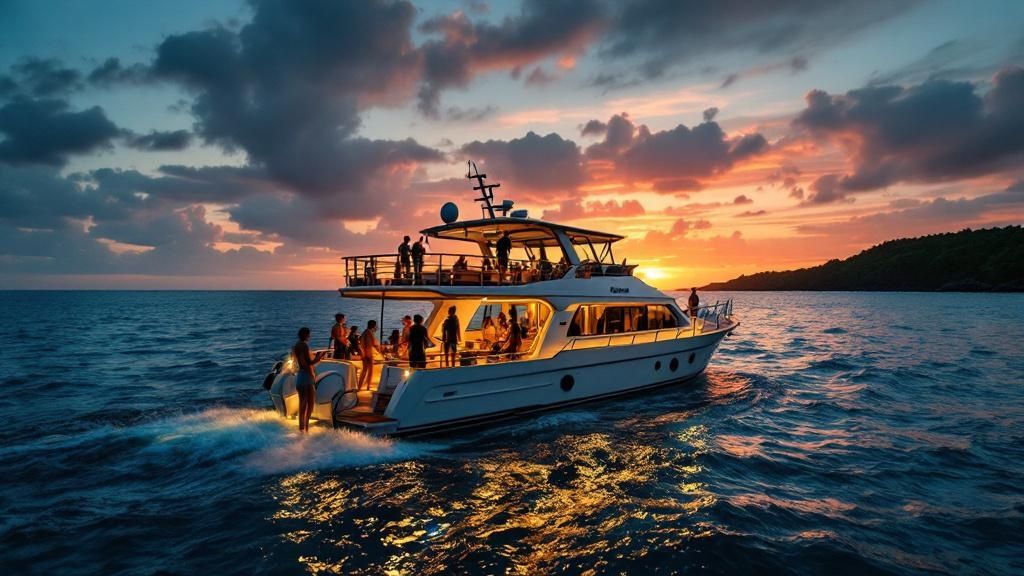Manta Ray Snorkel Big Island Night Tour Guide
- Byron
- Jul 21, 2025
- 15 min read
Picture this: you're floating in the calm, moonlit waters off the Kona coast. Suddenly, a magnificent manta ray, with a wingspan stretching over 12 feet, glides effortlessly just inches beneath you. This isn't a dream—it's the magic of the world-famous manta ray snorkel Big Island experience, a truly unforgettable underwater ballet. At Manta Ray Night Snorkel Hawaii, we specialize in making this incredible encounter a reality.
See what fellow adventurers have to say about their experience with us at Manta Ray Night Snorkel Hawaii.
Your Guide to an Unforgettable Manta Ray Encounter
The Kona coast of Hawaii’s Big Island isn't just a great spot for seeing manta rays; it's the global epicenter for it. Here, nature puts on a spectacular show every single night. As local experts, we at Manta Ray Night Snorkel Hawaii are thrilled to show you what makes this journey so incredible.
This adventure isn't just about watching marine life; it’s about becoming part of their world for a brief, magical moment. You'll hold onto a custom-made light board floating on the surface. These lights act like a dinner bell, attracting swarms of plankton—the mantas' favorite meal—and drawing them right below you for a stunning feeding display.
Why Is Kona the Manta Ray Capital?
The Big Island isn't just a random pitstop for these gentle giants; it's a world-class, year-round dining destination. The Kona Coast is known far and wide as the manta ray capital, home to a thriving local population of over 450 identified manta rays. The unique coastal geography and consistently warm, clear waters create the perfect feeding grounds, night after night.
This reliability leads to an incredible 85-90% sighting success rate on night tours, making it one of the most dependable wildlife encounters anywhere on the planet.
This isn't a passive viewing from a boat. The manta rays perform graceful somersaults and barrel rolls, coming so close you can see every detail of their patterned bellies. Each ray has a unique spot pattern, like a fingerprint, which researchers use to identify them.
For those ready to start planning this amazing trip, our comprehensive manta ray snorkel Big Island guide has even more tips and details to help you prepare.
What Makes This Experience So Special?
The Big Island manta ray snorkel is unlike any other marine interaction out there. It's a completely non-invasive, respectful way to observe these gentle giants as they feed in their natural habitat.
Here are a few highlights of what to expect:
A sunset boat ride along the breathtaking Kona coastline.
Effortless viewing while you comfortably hold onto a floating light board.
Up-close encounters with graceful, completely harmless manta rays.
Expert guidance from passionate marine life enthusiasts who keep you safe and share fascinating facts.
This experience is perfect for families, couples, and solo travelers looking for a story they’ll be telling for years. Ready to turn that inspiration into a reservation?
What to Expect on Your Manta Ray Snorkel Adventure
Your manta ray snorkel Big Island tour is so much more than just a quick dip in the ocean; it's an entire experience, starting with the classic magic of a Hawaiian sunset. The excitement is something you can feel the moment you step onto the boat. The trip begins with a beautiful ride along the Kona coast, a dramatic landscape where ancient volcanic cliffs drop straight into the Pacific. As the sun sinks and paints the sky with fiery oranges and purples, you can feel the anticipation building for the main event.

Once the boat anchors at one of Kona’s best manta feeding spots, like "Manta Village" or "Manta Heaven," the crew gets to work. They’ll set up a huge, custom-made floating light board. The best way to think of it is as an underwater campfire. Its bright, eco-friendly lights pierce the darkness, lighting up the water and attracting clouds of microscopic plankton—the mantas' favorite meal. This light board becomes your personal, front-row seat to one of the greatest shows in nature.
The In-Water Experience
As night fully falls, your guides will walk you through a clear safety briefing and get you kitted out with your snorkel gear and a wetsuit. The wetsuit is great for keeping you warm, but it also helps you float effortlessly. Next, you'll slip into the calm, surprisingly warm water and hold onto the sturdy rails of the light board. There's no hard swimming needed; you just float on the surface and gaze down into the illuminated water below.
The feeling is incredible. You'll notice the gentle rocking of the waves and see the plankton start to gather in the light beams, looking like a snowstorm in a snow globe. And then, it happens.
A dark, graceful shape emerges from the deep blue. The first manta ray glides into the light, its immense wings propelling it with impossible elegance. Soon, others may follow, creating a silent, mesmerizing underwater ballet.
Witnessing the Underwater Ballet
What unfolds next is pure magic. The manta rays perform beautiful somersaults and barrel rolls, their huge mouths wide open to filter the dense plankton from the water. They swoop and soar, often coming within inches of you without a hint of fear. Their size is just breathtaking; with wingspans that can average 12 feet, these are the true gentle giants of the sea.
You'll be so close you can see the unique spot patterns on their bellies, which researchers use like fingerprints to identify them. It’s a powerful and often humbling experience. Any nervousness you might have had just melts away, replaced by pure awe at how peaceful these amazing creatures are. This is exactly why a manta ray snorkel on the Big Island is always named one of the world's best wildlife encounters.
The Role of Your Guides
You'll typically be in the water for about 30 to 45 minutes, and your guides are with you every second. These aren't just boat hands; they are lifeguard-certified marine experts who are genuinely passionate about the mantas.
Their job is to do more than just point things out:
Ensuring Safety: They keep a close watch on everyone in the water, monitor the conditions, and make sure you feel completely safe and comfortable.
Providing Education: They share amazing facts about manta ray biology, their behaviors, and the local ecosystem, which really deepens your appreciation for what you’re seeing.
Protecting the Mantas: They enforce the strict "no touching" rule and other guidelines that make sure these encounters are safe and sustainable for the manta population.
Their knowledge and passion transform a fun activity into a truly meaningful experience. As you head back to the harbor under a sky full of stars, you'll carry with you a feeling of wonder that’s hard to describe.
Are you ready to witness this incredible spectacle for yourself?
How to Choose the Best Manta Ray Snorkel Tour
Picking the right company for your manta ray snorkel Big Island tour is the most important decision you’ll make. Honestly, it’s the difference between a pretty good trip and a completely unforgettable, ethical adventure. With so many options out there, it can feel overwhelming, but a few key things will help you find the perfect fit.
Your choice doesn’t just affect your night—it impacts the well-being of Kona’s beloved manta ray population.
The biggest factor? Go with a company that’s serious about conservation. You'll want to find operators who follow the strict standards originally set by the "Manta Ray Green List." Even though the official list isn't active anymore, its principles of responsible tourism are what separate the best tours from the rest. Companies like Manta Ray Night Snorkel Hawaii stick to these guidelines, always putting the safety and health of the mantas first.
Key Factors for Selecting a Tour
When you start comparing tours, it's easy to get bogged down in the details. Just focus on a few core features to make your choice simple. Think about the size of the boat, how long you’ll be on the water, and what’s included, like snacks, drinks, and gear.

The quality of the guides is another massive part of a top-tier experience. You want a crew led by experienced marine life experts and certified lifeguards. Their knowledge turns a simple swim into a real educational journey. They can share incredible facts about manta behavior, point out individual rays by their unique spot patterns, and answer all your questions, making the adventure so much richer. This expertise is just as crucial for your safety as it is for understanding these amazing animals. To learn more about what makes a trip truly exceptional, check out our ultimate guide to manta ray snorkeling tips.
Comparing Manta Ray Tour Features
With so many choices, a direct comparison can help you decide what's best for your group. This table breaks down the main differences between the small, intimate tours and the larger-scale operations.
Feature | Small Group Tours (e.g., Manta Ray Night Snorkel Hawaii) | Larger Group Tours |
|---|---|---|
Guest Experience | Intimate and personal, more one-on-one guide attention. | Can feel crowded, especially in the water. |
Manta Viewing | Unobstructed, front-row views are common. | You may have to navigate around more people for a good spot. |
Guide Interaction | Guides can easily answer questions and share personalized insights. | Less opportunity for individual interaction with the crew. |
Vessel Size | Smaller, nimble boats get you to the site quickly. | Larger vessels with more onboard amenities but less maneuverability. |
Eco-Focus | Typically very high, with a strong emphasis on sustainability. | Varies by operator; may be more commercially focused. |
Best For | Couples, families, and anyone seeking a high-quality, personal encounter. | Budget travelers or those who prefer the stability of a large boat. |
Ultimately, choosing between a small or large tour comes down to what you value most in an experience—personal attention and prime viewing, or the amenities of a bigger boat.
The Value of Small Group Tours
One of the biggest game-changers for a manta ray snorkel Big Island experience is the group size. While the bigger boats might have more deck space, they often lead to a very crowded time in the water. Smaller boats, on the other hand, deliver a much more personal and intimate adventure.
With fewer people around you, you get a front-row, unobstructed view of the manta "ballet." The guides can give you more personal attention, making sure you feel comfortable and get the absolute most out of your time with these gentle giants.
This personalized approach is what it's all about for operators focused on high-quality, sustainable tourism. They get that a better experience for you goes hand-in-hand with better practices for protecting the mantas. A careful, respectful approach is key to ensuring these incredible encounters can continue for years to come.
Safety Rules for Protecting Yourself and the Manta Rays
A successful and magical manta ray encounter is always a respectful one. When you slip into the water for a manta ray snorkel Big Island tour, you’re not just an observer—you’re a guest in their underwater home. Following a few simple but crucial rules ensures the safety of both you and these magnificent animals, preserving this incredible experience for future generations.

The Number One Rule: Never Touch a Manta Ray
If you take only one thing away from this guide, let it be this: never, ever touch a manta ray. It’s so tempting, I get it. They glide by so close you could just reach out. But touching them can cause serious harm.
Their skin is covered in a delicate, protective mucus layer that acts as a shield against bacteria and parasites. When you touch them, you strip away that vital coating, leaving them vulnerable to nasty skin infections. Think of it like visiting a living museum where the art is priceless, beautiful, and extremely fragile. You admire from a respectful distance to ensure it remains unharmed.
Becoming a Guardian of the Mantas
Your role during the snorkel is to be a passive observer. It's easy! By following a clear set of guidelines, you actively help protect Kona's manta population. These rules make the experience better for everyone, especially the mantas themselves.
Essential Manta Snorkel Guidelines:
Be a Passive Observer: Just float calmly and let the mantas come to you. Their natural curiosity often brings them incredibly close—no need to chase.
Keep Fins and Feet Up: Always stay horizontal on the surface. Kicking down can accidentally hit a manta as it passes below, injuring its delicate skin or eyes.
No Camera Flashes: Sudden, bright flashes can disorient and scare the mantas. Turn off your camera's flash and use the light from the main float to illuminate your shots.
Never Chase or Block: Don't swim after, dive toward, or get in a manta's way. This causes them stress and can disrupt their natural feeding patterns.
Understanding your gear is another key part of staying safe. While tour operators provide everything you need, learning in advance about things like how to pick inflatable life vests can give you extra confidence and peace of mind on the water.
Protecting a Fragile and Unique Population
Following these rules is especially critical here on the Big Island. While Kona is famous for its manta encounters, recent genetic studies have revealed something startling: the local population is surprisingly small and completely isolated.
Estimates show there are only about 104 adult breeding reef manta rays in the waters around Hawaiʻi Island, and they are genetically distinct from populations on other islands.
This isolation makes every single manta ray absolutely vital to the health and future of the local population. When you snorkel responsibly, you're not just a tourist—you're a guardian helping these gentle giants thrive.
For more helpful information, be sure to check out our guide on the top tips for your Big Island manta snorkel. Your mindful participation makes a world of difference.
How to Prepare for Your Night Snorkel Tour
A little bit of prep work makes a world of difference for your manta ray snorkel Big Island adventure. When you're comfortable and have everything you need, you can focus on what really matters: the incredible show unfolding just below you.
While tour operators like us at Manta Ray Night Snorkel Hawaii provide all the core gear like wetsuits and snorkels, there are a few personal items you’ll be glad you brought along.
Trust me, after floating in the ocean for 30-45 minutes at night, that boat ride back to the harbor can feel surprisingly chilly, even in Hawaii’s warm climate. Being prepared is key.

Your Essential Packing Checklist
Keep it simple. You don't need to haul a massive bag, but these few things will make your trip so much more comfortable.
Towel and Dry Clothes: This is an absolute must. Having a dry, fluffy towel and something warm like a sweatshirt and pants to change into after your snorkel makes the ride home cozy and comfortable.
Reef-Safe Sunscreen: For sunset tours, it's a great idea to apply sunscreen a few hours before getting on the boat. This gives it time to soak in, protecting your skin without washing harmful chemicals onto Hawaii's fragile coral reefs.
Reusable Water Bottle: Staying hydrated is always important. Most tours offer water, but bringing your own bottle is a great, eco-friendly habit.
Seasickness Medication: If you even think you might get motion sickness, take your preferred medication before the boat leaves the harbor. The ride is usually smooth, but it’s always better to be safe than queasy.
While this list covers your tour, it's also smart to check out general packing and safety tips for beachgoers to make sure your whole day goes off without a hitch.
Addressing Common Concerns
We get a lot of questions from first-timers, especially about the physical side of things. The best part? This experience is incredibly accessible, no matter your swimming level.
"I'm Not A Strong Swimmer. Can I Still Go?"
Yes, absolutely! You don't need to be a gold-medal swimmer to do this. In fact, you barely have to swim at all.
You'll be holding onto a large, sturdy flotation board the entire time you are in the water. These boards have bright lights attached, and your wetsuit adds extra buoyancy. All you have to do is float and watch the amazing ballet below.
This design makes the whole experience relaxing and completely safe, even if you’re not the most confident in the water.
"What Happens If The Weather Is Bad?"
Your safety is always the number one priority. Tour operators are constantly watching the weather and ocean conditions. If things look unsafe because of high winds, big swells, or storms, the tour will be canceled.
When this happens, you'll be offered a full refund or the chance to rebook for another night. This is a great reason to book your manta tour early in your vacation—it gives you plenty of time to reschedule if Mother Nature doesn't cooperate.
For an even deeper dive into making your trip perfect, check out our 10 essential manta ray snorkel tips.
With just a little planning, you'll be all set for an unforgettable and comfortable evening with Kona's gentle giants.
Common Questions About Manta Ray Snorkeling
Even with all the excitement bubbling up, it's completely normal to have a few questions before you take the plunge on a manta ray snorkel Big Island tour. Jumping into a unique adventure always comes with a little bit of uncertainty, but we're here to give you clear, straight-up answers to put your mind at ease.
We've heard just about every question in the book from fellow adventurers. Our goal is simple: to make sure you can book your tour feeling totally confident and knowing exactly what’s in store. A little information goes a long way in making a perfect night, and at Manta Ray Night Snorkel Hawaii, we believe a prepared snorkeler is a happy snorkeler.
So let's dive into the details and clear up anything you might be wondering about.
Is Seeing Manta Rays Guaranteed on the Night Snorkel?
This is the big one, and the honest answer is that we're always on Mother Nature's schedule. Because manta rays are wild animals in their own home, no one can ever truly promise a 100% guarantee. That said, the Kona Coast is famous for being one of the most reliable places on the entire planet to see them.
Reputable tour operators have an incredibly high success rate, often over 90%, all year round. The secret is the established feeding sites. Our bright lights consistently draw in the plankton, and that, in turn, brings the mantas for their nightly meal.
But what if you hit that rare night when the mantas decide to skip dinner? Most top-tier companies offer a "manta guarantee." This usually means you get to join another tour on a different night, completely free. It's always smart to check on this policy when you book.
This is exactly why we always suggest scheduling your manta tour early in your vacation. It gives you a nice buffer to reschedule if the weather doesn't cooperate or the mantas are a no-show.
What Is the Best Time of Year to Go?
Here's the great news: there really is no "best" time of year to snorkel with manta rays on the Big Island! The experience is absolutely incredible year-round. Unlike animals that migrate, Kona’s manta rays are residents who stick around the area all year. They show up for their plankton buffet no matter the season.
This gives you fantastic flexibility when planning your trip. The decision usually just comes down to your personal preference for weather.
Summer (June - September): This is when you'll find the warmest air and water temperatures, making your time in the ocean super comfortable.
Winter (December - March): The water might be a little cooler, but visibility can be crystal clear during these months, offering breathtakingly sharp views of the mantas.
Honestly, the best time to go is whenever fits your travel plans. The mantas will be here waiting for you. For an even deeper dive, check out our ultimate guide to manta ray snorkeling for more tips on planning the perfect visit.
I'm Not a Strong Swimmer Can I Still Do This Tour?
Yes, you absolutely can! This is a super common worry, but you don't need to be an Olympic swimmer to have an amazing time. The whole experience is designed to be safe and accessible for people of all comfort levels in the water.
Once you get in, you'll be holding onto a large, custom-made flotation board for the entire duration. Just think of it like a floating handrail. These boards are very stable and have the bright lights that attract the plankton and mantas. You won't have to swim around on your own at all.
Your only job is to float, hold on, and put your face in the water with a mask to enjoy the show. The wetsuit we provide also makes you extra buoyant, so floating is effortless. Our guides are right there in the water with you to help out and make sure everyone feels safe and secure. If you're comfortable floating in a pool, you're ready for this.
Is the Manta Ray Night Snorkel Safe?
Safety is the number one priority for every professional tour company, and yes, the manta ray night snorkel is a very safe activity. First off, the manta rays themselves are completely harmless. There's a reason everyone calls them "gentle giants."
Manta Ray Safety Facts:
They don't have teeth for biting.
They have no stinger or barb like their stingray cousins.
They are filter feeders, eating only microscopic plankton.
Their only real interest in people is simple curiosity. The main safety concerns just come with being on a boat and in the ocean after dark. This is where choosing a professional, reputable company makes all the difference.
The best operators have highly trained, lifeguard-certified guides and seasoned boat captains. They give thorough safety briefings, provide all the necessary gear (like life vests), and keep a constant eye on the ocean conditions. When you go with a team that puts safety first, you can relax knowing both you and the mantas are in great hands.
What Is the Difference Between Snorkeling and Diving?
The main difference between snorkeling and diving with the mantas comes down to your vantage point. It's all about your perspective in the water.
Snorkelers: You float right on the surface, holding onto a big light board. You look down as the mantas glide up towards the light, often coming within inches of you. It's a breathtaking, face-to-face experience.
Divers: If you're a certified scuba diver, you'll go down to the ocean floor, usually about 35 feet (11 meters) deep. You'll settle in a designated spot and point your dive lights up. This creates a "campfire" of light that attracts the plankton, and you get to watch the mantas dance in their acrobatic ballet above you.
Both options are spectacular and offer unforgettable views. Snorkeling is just more accessible for everyone, including families and people without dive certifications, while diving offers a unique, bottom-up perspective. Either way, you're in for a night you'll never forget.
Comments